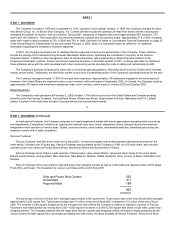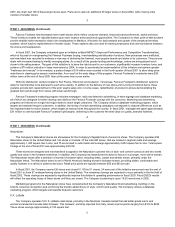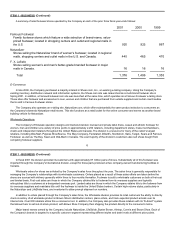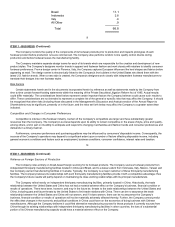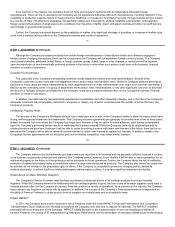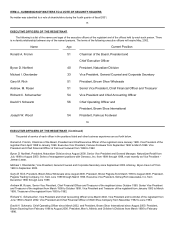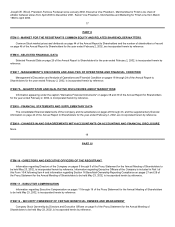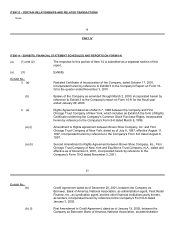Famous Footwear 2002 Annual Report Download - page 6
Download and view the complete annual report
Please find page 6 of the 2002 Famous Footwear annual report below. You can navigate through the pages in the report by either clicking on the pages listed below, or by using the keyword search tool below to find specific information within the annual report.
Brazil 11.1
Indonesia 2.8
Italy .4
All Other .9
Total 66.8
9
ITEM 1 - BUSINESS (Continued)
The Company monitors the quality of the components of its footwear products prior to production and inspects prototypes of each
footwear product before production runs are commenced. The Company also performs random in-line quality control checks during
production and before footwear leaves the manufacturing facility.
The Company maintains separate design teams for each of its brands which are responsible for the creation and development of new
product styles. The Company's designers monitor trends in apparel and footwear fashion and work closely with retailers to identify consumer
footwear preferences. From a design center in Florence, Italy, the Company captures European influences like heel shapes and fabrics before
appearing at retail. The design center is electronically linked to the Company's line builders in the United States who blend them with the
latest U.S. fashion trends. When a new style is created, the Company's designers work closely with independent footwear manufacturers to
translate their designs into new footwear styles.
Risk Factors
Certain statements herein and in the documents incorporated herein by reference as well as statements made by the Company from
time to time contain forward-looking statements within the meaning of the Private Securities Litigation Reform Act of 1995. Actual results
could differ materially. The considerations listed below represent certain important factors the Company believes could cause such results to
differ. These considerations are not intended to represent a complete list of the general or specific risks that may affect the Company. It should
be recognized that other risks (including those discussed in the Management's Discussion and Analysis section of the Annual Report to
Shareholders) may be significant, presently or in the future, and the risks set forth below may affect the Company to a greater extent than
indicated.
Competition and Changes in Consumer Preferences
Competition is intense in the footwear industry. Certain of the Company's competitors are larger and have substantially greater
resources than the Company. The Company's success depends upon its ability to remain competitive in the areas of style, price and quality,
among others, and in part on its ability to anticipate and respond to changing merchandise and fashion trends and consumer preferences and
demands in a timely manner.
Furthermore, consumer preferences and purchasing patterns may be influenced by consumers' disposable income. Consequently, the
success of the Company's operations may depend to a significant extent upon a number of factors affecting disposable income, including
general economic conditions and factors such as employment, business conditions, consumer confidence, interest rates and taxation.
10
ITEM 1 - BUSINESS (Continued)
Reliance on Foreign Sources of Production
The Company relies entirely on broad-based foreign sourcing for its footwear products. The Company sources footwear products from
independent third-party manufacturing facilities located in China and Brazil, and to a lesser extent from Indonesia, Italy, Mexico, Taiwan and
two Company-owned manufacturing facilities in Canada. Typically, the Company is a major customer of these third-party manufacturing
facilities. The Company believes its relationships with such third-party manufacturing facilities provide it with a competitive advantage; thus
the Company's future results will partly depend on maintaining its close working relationships with its principal manufacturers.
The Company relies heavily on independent third-party manufacturing facilities, primarily located in China. Historically, the trade
relationship between the United States and China has not had a material adverse effect on the Company's business, financial condition or
results of operations. There have been, however, and may in the future be, threats to the trade relationships between the United States and
China, including past and future threats by the United States to limit trade relations with China. There can be no assurance the trade
relationship between the United States and China will not worsen, and if it does worsen, there can be no assurance the Company's
business, financial condition or results of operations will not be materially adversely affected thereby. Further, the Company cannot predict
the effect that changes in the economic and political conditions in China could have on the economics of doing business with Chinese
manufacturers. Although the Company believes it could find alternative manufacturing sources for those products it currently sources from
China through its existing relationships with independent third-party manufacturing facilities in other countries, the loss of a substantial
portion of its Chinese manufacturing capacity would have a material adverse effect on the Company.


